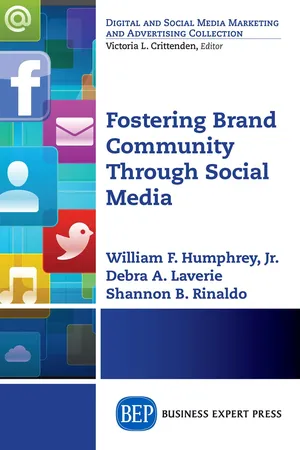![]()
CHAPTER 1
The Online Brand Community
Social media is a powerful tool in the Integrated Marketing Communications mix. Companies cultivate fans on Facebook, respond to tweets on Twitter, and encourage consumers to post their brand interactions on Pinterest. Managing the social media platform is a delicate balance for many companies, especially since consumers control much of the content. So how can companies manage their online relationships with customers in a way that can lead to brand loyalty? We present a conceptual model to detail factors managers should consider in using social media to build brand community. We discuss the benefits of a strong brand community and offer examples of how brands are effectively building community through social media. The following discussion is based on theory, academic research, and practice.
A brand community is a specialized community where the “primary base of identification is a brand or brand consumption activity.”1 These communities are growing as brand managers have increasingly focused on consumers’ relationships with brands.2 Brand community is a prominent form of consumer–brand relationship3 where brand users with similar interests and experiences come together in a social group.4 The community is a focused community that is not geographically bound; it is grounded in social relationships among users of a particular brand. One thing that sets brand communities apart from other social clubs is the brand. The community is most often formed around a publicly consumed brand, rather than a product that is consumed in private.
Brand communities are built on a sense of emotional involvement with the brand and the group. These communities engage in actions that often are related to common goals. For instance, there are many brand communities focused on the Jeep brand. These consumers gather, interact, and together pursue activities to see what extremes they can pit their Jeeps through (trail riding, rock climbing, and water passings). They provide support and recommendations, and engage in sharing brand experiences. Brand communities form their own norms and rituals. Interaction in a community increases feelings of integration into the Jeep brand community and positive feelings about the product category and the brand. Participants derive social and hedonic value from participation and often participate in product alterations and design.
Companies encourage brand admirers and strengthen consumer relationships with one another as well as the brand to create brand communities. The now-defunct automobile brand Saturn was the first automobile company to create a community. The company devoted considerable resources (e.g., money, people, time, and events) to build the brand community. Saturn owners were invited annually to the company’s Springhill, Tennessee (USA) plant, where the Saturn drivers enjoyed company-sponsored activities, gathered with other drivers, and met the people who made their cars. The goal of these gatherings was to strengthen the “Saturn Family” as well as the Saturn brand. The thought was that the more connected drivers felt to one another and the brand, the more likely they were to stay loyal when purchasing their next vehicle. On the other hand, brand communities can emerge organically. Organic brand communities are analogous to fan clubs where individuals with mutual admiration for an entity come together to share information, knowledge, experience, and identity without explicit sanctioning from the company managing the brand.5
Brand communities may also get their beginnings as consumer-created, but later gain support from the company. The first Corvette-related club was started in 1956, three years after the first cars rolled off the assembly line. According to the website for the Corvette Club of America, the goals of the club included promoting Corvette ownership, operation, and knowledge. Although many consumer-maintained Corvette brand communities still exist, the Corvette plant in Bowling Green, Kentucky (USA) has hosted a “Homecoming” annually since 1980 and actively supports the National Council of Corvette Clubs, an organization of more than 275 smaller clubs with the motto “We joined for the car, we stay for the people.” These brand communities create a unique form of brand equity.
Brand Communities and Social Media
Brand managers have long understood that relational and experiential aspects of consumption are important for building relationships with consumers.6 Historically, companies lookin...
